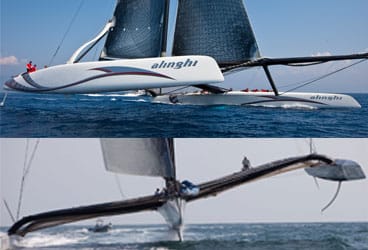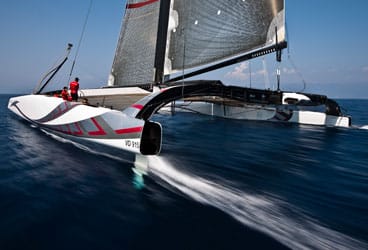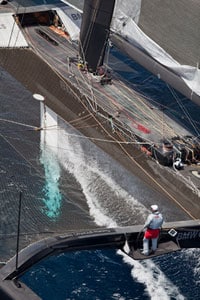
Gilles Marin-Raget/BMW Oracle Racing and Carlo Borlenghi/Alinghi| |Wider equals faster, usually. The more beam a multihull has, the more sail it can carry. BMW Oracle Racing’s trimaran (bottom) has an advantage over Alinghi’s catamaran (top) in this respect. However, the cat, with two hulls as opposed to three, is likely lighter.| They may disagree, the few thousand people forced to seek alternative employment as a result of the two-year (and counting) America’s Cup legal feud between Ernesto Bertarelli and Larry Ellison. But the battle of the sailing billionaires has one big upside: the creation of two ground-breaking craft. Not since the era of the J-Class yachts has the America’s Cup seen such revolutionary designs. While the multihull dust-up next February in Ras Al-Khaimah is unlikely to feature any of the close racing of Valencia 2007, as a technological showcase and on-the-water speed fest, the 33rd match will be unparalleled.
That’s hardly idle praise considering the recent performances turned in on the North Atlantic by mega multihulls. While setting a new transatlantic record, the Banque Populaire V maxi-trimaran lifted the 24-hour record to a remarkable 908.2 miles. At 131 feet, BPV is longer than both Alinghi’s catamaran and BMW Oracle Racing’s trimaran, but is more conservative in many respects. BPV’s beam-often the best indicator of the power of a multihull-is a modest 75 feet. The BMW Oracle Racing trimaran is 90 feet wide, the Alinghi cat only slightly narrower. BPV’s mast height is a towering 154 feet, but come next February, the rigs on the America’s Cup contenders are expected to approach 200 feet, while each boat’s all-up displacement should still be less than Banque BPV’s 26 tons.
So it’s within reason to expect these America’s Cup multihulls to be capable of 25 knots upwind and 50 knots on a reach. Sadly, however, in the light sea breeze conditions off the United Arab Emirates, teams will not be looking for ultimate speed, but for ultimate efficiency in 10 to 15 knots. The big question is, in these conditions, which will do that more effectively?

Carlo Borlenghi/Alinghi| |**To overcome the inherent stiffness concerns in such a wide catamaran, Alinghi’s designers use an innovative system of composite rigging running under the trampoline both side-to-side and fore-and-aft. **|
Alinghi 5
Cloaked in secrecy during its build, there was rampant rumor about what the new giant Alinghi multihull would look like. Only in early July was the public allowed its first glimpse of the America’s Cup defender’s futuristic-looking catamaran.
The most astonishing aspect is its extreme beam, which is 80 to 90 percent of the 90-foot waterline length. This gives the boat one of the highest beam-to-length ratios of any catamaran ever built.
The choice of a catamaran, however, shouldn’t be a surprise. For two decades, syndicate head Ernesto Bertarelli has successfully helmed state-of-the-art catamarans on Lake Geneva, including the 41-foot Le Black, which was retired after winning the Bol d’Or race three times from 1997 to 2001, and more recently the Alinghi D35 one-design. The D35’s beam-to-length ratio is 63 percent; however, these boats could almost be considered trimarans due to a central hull that never touches the water, but helps with fore-and-aft rig tension. Catamarans typically struggle upwind due to forestay sag. In this sense, Alinghi 5, which has no center hull, is a more conventional catamaran.
Its two crossbeams are immense. Equally as substantial are the 50- to 60-foot bowsprit, which extends from the mast step to forward of the bows, and the two additional aft support beams, which run diagonally from the mast step to the aft beam. To sustain the forestay tension necessary for upwind performance, Alinghi 5 has a complex network of composite rigging running beneath its fore-and-aft beams.
“The biggest problem with cats, and any multihull, is that stiffening it out with the hulls and the beams is nearly impossible,” says Rolf Vrolijk, Alinghi’s lead designer. “Sometimes you have angled beams and all kinds of other solutions, but here all the rig loads are going straight into the spines and the rigging [beneath the crossbeams]. There is no mast force going into the hulls other than the forward thrust of the sails. That is the biggest difference with this kind of structure.”
This solution allows the team to crank up rig tension through the use of powered hydraulics. “You can really pull it up to max tension,” says Vrolijk. “You have to. It is like an iceboat: the more you pull on the sheets, the flatter you make the sails, the faster it goes. And downwind it is the same, your apparent wind comes around the front and it is only a 10-degree difference [from upwind]. It is always apparent wind from the front and it’s always flat sails, and max tension makes you go fast.”
Offshore maxi-cats typically have three crossbeams-aft, main, and forward-with the middle beam supporting the mast step. Alinghi 5 did without the forward crossbeam, which reduces weight and the possibility of the beam burying into waves. However, the challenge of this arrangement is that the two bows lack lateral support-at least against inward bending-forward of the mast step. A decade ago, Pete Goss’s radical Team Phillips catamaran tried this and failed, with one bow snapping off forward of the main crossbeam during a shakedown sail. To prevent this from happening on Alinghi 5, the hulls have their largest cross-sectional area at the main beam, tapering considerably forward and less so aft.
An unusual feature of the boat is that the two crossbeams are shaped differently. The main beam is a shallow inverted ‘V,’ while the aft beam is arched where it connects with the hulls. According to Dirk Kramers, Alinghi’s Chief Structural Engineer, this is due to the differing bending moment between the hull and cross beams. “Quite a large part of the load that goes into the forward beam is bending moment from the daggerboards,” says Kramers, “while the aft beam has the curve on it for water clearance.”
Kramers may well have Alinghi’s most difficult and important task. Sailing these maxi-multihulls isn’t as much about maximizing hull speed, as a sailing a monohull might be, as it’s a job of managing the loads coursing through the boat and rig. It’s very easy to take the boat into the danger zone in regard to catastrophic failure. On Alinghi 5, the highest loads are seen in the forward beam and bowsprit when the reacher is flying. According to Vrolijk, this load could be as much as 110 tons. So serious an issue is the loading that the team embedded into the laminate a fiber-optic lattice, which relays to the crew real-time information on the stresses being inflicted on the boat. This is a development of the work Alinghi previously carried out with its research partner, the Ecole Polytechnique Federale de Lausanne (EPFL) for the 32nd America’s Cup. One EPFL engineer’s sole job is to monitor the output from the grid.
Aside from managing the monster loads and nursing their beast around the course at the fastest speed they dare, the other issue that will be important for the crew is tacks. Multihulls, from Hobie Cats upward, lack the mass to maintain momentum through a tack. But these monsters, with their monster rigs, have added a new wrinkle.
“Because you have this huge mast, the windage is so big,” says Vrolijk. “If the mast is not pushing anymore, it is stopping you, like you are hitting a wall. When the boat stops you have to be at the right angle to accelerate again. If you aren’t, you’ll go backwards.”
Between the two flavors of multihulls, trimarans have the upper hand in this maneuver. However, in Switzerland, over the last couple of decades, multihull sailors have proven that cats with adequate rocker can swap tacks as quickly, if not more so, than their three-hulled brethren. Regardless, tacking duels are not likely to be a big part of the 33rd America’s Cup.
What many purists will dislike about Alinghi 5 is the generator attached the rear crossbeam. All grinding on the boat is carried out with the push of a button. Unlike much of the boat, this isn’t new technology, rather a philosophical point about whether stored energy systems such as this should be allowed in sailing’s pinnacle event. But even with push-button technology, the crew will still face the Herculean task of moving sails around and the mental challenge of having so much more to tweak than on the ACC monohulls. All of this will happen at a furious pace compared to what they were used to, with each adjustment capable of making a profound difference in performance.
-James Boyd

Gilles Marin-Raget/BMW Oracle Racing| |**With both teamsallowed to use auxiliary power, the center hull on BMW Oracle Racing’s trimaran, originally configured with four grinding pedestals, will likely be undergoing some significant modifications. **|
BMW Oracle Racing 90
Sailing the leaden America’s Cup Class yachts was hardly easy or free of anxiety. Their narrow beams necessitated extreme loads on the rig and the hull. But compared to BMW Oracle Racing’s trimaran, those monohulls are a walk in the park. It’s not simply the astounding speeds of the multihull, says BMW Oracle Racing design director Mike Drummond. The key difference is a little harder to describe.
He tries it this way: Imagine, he says, that you have a marble in a broad bowl. Moving the marble to another part of the bowl is a fairly simple process: tilt the bowl and the marble will roll, overshoot its intended position, roll back in the opposite direction, and eventually come to rest exactly where you want. This, says Drummond, is a monohull. If you’re at 20 degrees of heel and you’d rather be at 15, you make one or more of a number of possible changes-head up, flatten sails, ease sheets-and the boat will settle into a new equilibrium.
To simulate a racing multihull, he continues, turn the bowl upside down and balance the marble on the top. To move this marble, you’ve got to tilt the bowl one way to get it rolling, then tilt it back the opposite way to get it to stop. And you’ve got to do this all precisely and quickly because if you don’t, the marble will roll right off.
To emphasize his point, he tells a story of one of his early experiences in a 16-foot A Class catamaran. He capsized in winds so light that most race committees would struggle to start a race.
For Drummond it was a powerful lesson. His latest project-BMW Oracle Racing’s 100-foot trimaran-is a really heavy and fragile marble balanced on top of an extra large bowl. The consequences of it crashing to the floor will be catastrophic to his employer’s attempts to bring the America’s Cup back to home soil, and potentially harmful, fatal even, to the crew.
As Drummond provides this explanation, the object of his attention for the past year and change is closing in from behind. The spindly 100-foot monster has only the main up, and yet it’s having no trouble outpacing all the support boats escorting it out San Diego Bay.
The boat sailing this day in early August is BMW Oracle Racing’s challenger for the 33rd America’s Cup. However, it will be a different boat come February. “We will be making modifications to this boat,” says BMW Oracle Racing CEO Russell Coutts, “significant modifications, really.”
Part of this is due to the planned evolution of the boat, which was designed and assembled in relatively short order given the scale and complexity of the project. “When they first challenged at the end of AC 32, they didn’t have a lot of time to contemplate the design,” says multihull designer Pete Melvin, who has done some sailing on the trimaran. “It’s a little bit more of a scaled-up ORMA 60 than something off a fresh sheet of paper, but it actually is quite a good configuration.”
But the most significant modifications will be a result of Alinghi’s July announcement that Rules 49 to 54 in the Racing Rules of Sailing, which include prohibitions against auxiliary power and moveable ballast, will not apply for the 33rd match. Rather than relying on human power-the trimaran was initially configured with four grinding pedestals to power the winches and hydraulics-the boat will use an auxiliary engine to turn the winches and cant the rig.
“You’d rather design the boat [to have powered winches and hydraulics] from Day 1,” says BMW Oracle Racing helmsman James Spithill, who along with tactician John Kostecki has been in charge of the day-to-day sailing and development of the trimaran. “Still, the winches are the winches. We’ve got a pretty good engine team assembled. But with any componentry with this boat you’ve got teething problems.”
The flip side is that the American team was sailing and developing its trimaran for the 10 months before Alinghi’s catamaran splashed into Lake Geneva in July.
As with every America’s Cup effort, time is the most valuable commodity. Optimizing a multihull of this size is a painstakingly slow effort. A good day involves eight hours or more on the water for an hour’s worth of data points to compare against the theoretical predictions for the boat.
Steering the boat, says Spithill, is an extremely draining exercise. Unlike the ACC monohulls, where the limits were fairly well defined, sailing the trimaran is like trying to find the stairs at the end of a dark hallway. “You really have to be on the edge to be going fast,” says the 30-year-old Spithill. “It’s an interesting balance that we have to live with. We have to push a boat of this size, but a small mistake can lead to the end of the campaign.”
To help keep the boat in one piece, there’s an advanced neural network of strain gauges and load sensors placed throughout the boat. Whenever a part gets too close to its working limit, an alarm goes off. It’s not a pleasant sound, says John Kostecki, but it’s one the team hears quite regularly. “It’s part of the game,” he says, “pushing the boat to its limit. So the alarms go off frequently. We’re used to it.”
Two of the most noticeable modifications the team made as a result of its initial test program involve the amas, or floats, and the mast. The original amas featured a plumb stem, and were designed to handle rougher conditions. With the 33rd Cup match slated for the light winds and flat waters off Ras Al-Khaimah in the United Arab Emirates, the team has swapped those amas for a more aggressive design featuring a reverse bow profile and slightly more length.
“There’s always a desire to reduce weight and windage on these boats,” says Melvin, who uses a similar concept in his A cat designs. “Windage turns out to be quite a large percentage of the total resistance, especially on a boat with such high apparent windspeeds.”
The reverse bow helps the boat punch through, rather than ride over waves. This provides a smoother ride with less shock loading. While the boat is constrained to 90 feet on the water line, the floats are in excess of 100 feet, giving the boat better fore and aft stability and reducing the amount of pitching the boat experiences.
The second major summer modification to the boat is the introduction of a new rig, the tallest of three built for the boat. At 185 feet, the Hall Spars mast is greater than twice the length of the main hull and carries a 6,800-sq. ft. rectangular mainsail, a 6,700-sq. ft. genoa, and an 8,400-sq. ft. gennaker. The downwind sail area of 15,200 sq. ft., is nearly equal to that carried by the 189-ton Reliance in the 1903 America’s Cup and double what the 166-ton Ranger flew to win the 1937 America’s Cup. The displacement of the BMW Oracle Racing trimaran is secret, but there’s no doubt it’s but a small fraction of what those two boats weighed.
The nature of the Deed of Gift course-either a 40-mile windward-leeward loop, or a 39-mile triangular course with a beat and two broad reaches-means the boats aren’t likely to set any speed records during the 33rd America’s Cup match. As with most boats, the fastest point of sail is slightly low of a beam reach. However, that hasn’t stopped BMW Oracle Racing from testing the outright potential of the trimaran. According to Spithill the team has sailed the boat in excess of 40 knots. They’ve also sailed it in 40 knots of wind, under bare poles.
How fast did they go without a scrap of sail area exposed?
“Too fast,” says Spithill, before confirming that they were moving faster with no sails than an ACC monohull went under full sails.
If wind predictions for Ras Al-Khaimah are correct, that the trimaran can sail at 40 knots, or in 40 knots, is of little consequence. What will matter, says Drummond, is which boat can get up on one hull faster. Traditionally trimarans have had an advantage-due largely to less wetted surface-in very light winds. Once the breeze is such that Alinghi’s catamaran can fly a hull, the tables may turn in favor of the lighter catamaran platform. During its inaugural sail, the cat flew a hull in single-digit windspeeds. And, of course, stacking on more sail area could enable both boats to sail on one hull in very light winds. But there is still a lot of time left for development. Both teams are considering hard wing sails, which would be among the biggest fixed airfoil shapes ever produced-the wingspan of a 747 is 212 feet. In fact, given how the most contentious, litigious, and anticipated Cup match has played out thus far, nothing is out of the question.
-Stuart Streuli









